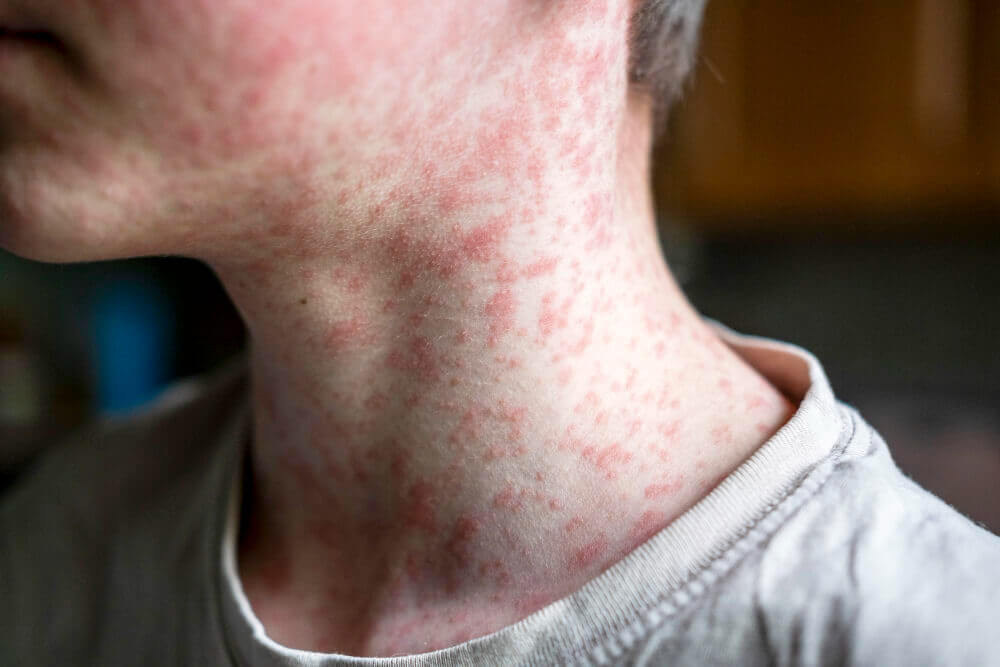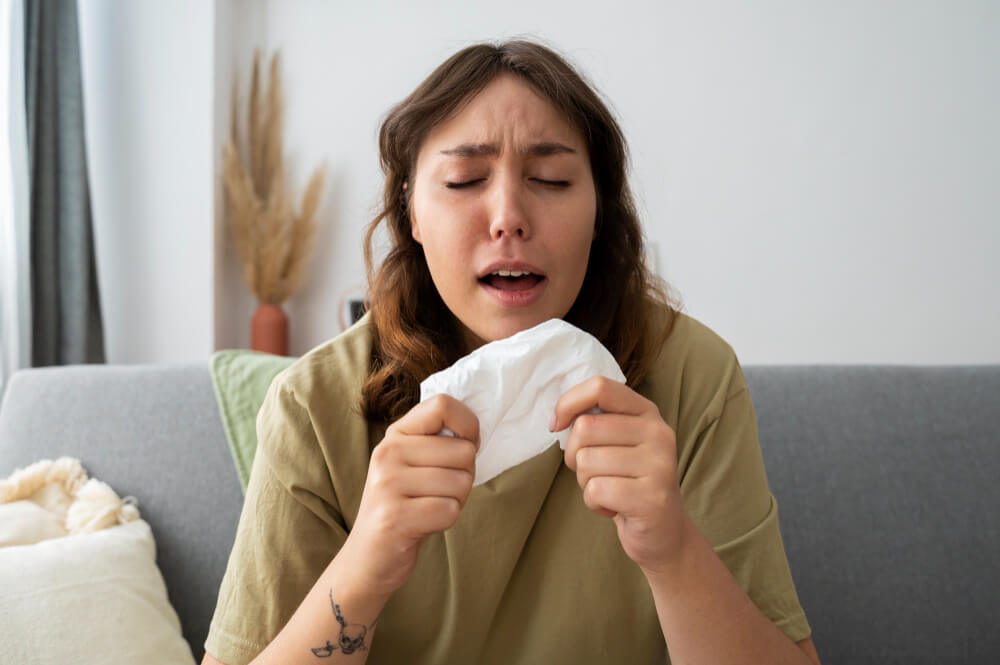- Fast results
- 4,000+ locations
- 4.8 star rating
Need Help? (888) GET LABS


Confirming your immunity to Measles, Mumps, and Rubella (MMR) can define your efforts to secure personal health and public safety, especially given the resurgence of these preventable diseases in various parts of the world. Understanding the methods for verifying immunity allows individuals to make informed decisions about vaccination and potential exposure risks. This process involves reviewing vaccination records, undergoing serological testing, and, in some cases, considering historical documentation of past infections.
In this guide, you’ll learn more about the value of checking how effective the MMR vaccination is and the consequences of a compromised or ill-equipped immune system against these viruses. Read on to know the details.
Pro tip: The most surefire way to check your immunity to measles, mumps, and rubella is to take the Measles, Mumps, Rubella (MMR) Immunity Profile Blood Test. This serological test can help confirm if you have already been exposed to the viruses either through vaccination or infection.
Establishing immunity to MMR via vaccinations is crucial for preventing outbreaks and protecting vulnerable populations. Serological testing, specifically the blood test for immunity to measles, mumps, and rubella that measures IgG antibodies, remains the gold standard for confirming immunity.
Recent research underscores the importance of accurate and reliable serological assays. For instance, a study published in BMC Infectious Diseases highlighted the variability in commercial MMR IgG assays(1) and emphasized the need for standardized testing protocols. Doing so ensures accurate interpretation of results and prevents misclassification of immunity status.
A positive serology result indicates prior exposure to the virus, either through vaccination or infection, and confirms the presence of protective antibodies. Additionally, a documented history of receiving two doses of the MMR vaccine, administered according to the recommended schedule, is widely accepted as evidence of immunity in most healthcare and educational settings. This documentation should include the vaccination dates and the vaccine manufacturer, which are usually found on official immunization records.
The MMR vaccine elicits immunity by introducing attenuated (weakened) live viruses that stimulate the body’s immune system. As the viruses invade the body, the immune system produces antibodies and memory cells that combat and try to eliminate these pathogens, thus providing long-lasting protection against measles, mumps, and rubella.
Immune cells play a significant part in building the body’s immunity. The vaccine’s formulation is designed to elicit both humoral (antibody-mediated) and cellular (T-cell-mediated) immune responses, contributing to its overall effectiveness.
A study published in the Journal of Clinical Investigation investigated the T cell response following MMR vaccination(2), revealing the generation of robust and durable memory T cells, particularly CD8+ T cells, contributing to long-term immunity.
Additionally, investigations into the impact of maternal antibodies on infant immune responses to the MMR vaccine have provided valuable insights. In a study on eClinicalMedicine, the influence of maternal MMR antibodies(3) on the efficacy of infant MMR vaccination was explored, highlighting the importance of timing and dosage to ensure optimal immune responses in young children.
The MMR vaccination is essential for safeguarding public health and preventing the resurgence of measles, mumps, and rubella. Maintaining high vaccination rates is crucial to avoid outbreaks that can overwhelm healthcare systems and disproportionately affect vulnerable populations. The economic burden of managing outbreaks, including hospitalization costs and lost productivity, underscores the importance of proactive vaccination strategies.
The standard vaccination schedule for the MMR vaccine(4) recommends two doses. Usually, children get their first shot between 1 and 1.25 years old or 12-15 months of age. The second dose is then given between 4 and 6 years of age, usually before the child enters school. This two-dose regimen is designed to provide optimal protection against all three viruses. Adhering to this schedule is crucial for establishing robust and long-lasting immunity.
While the two-dose schedule is standard, specific circumstances may necessitate adjustments. For example, during outbreaks, healthcare providers might recommend earlier vaccination or additional doses for specific populations.
Adults who have not received two doses of the MMR vaccine should also consult their healthcare provider for vaccination. Additionally, individuals traveling internationally, especially to regions where measles is prevalent, should ensure they are up-to-date on their MMR vaccinations.
Widespread vaccination creates herd immunity to measles, mumps, and rubella, protecting those who cannot be vaccinated for medical reasons and minimizing the risk of outbreaks. Otherwise, individuals who acquire the infection may succumb to the following health consequences, and even sepsis and death.

Measles is a highly contagious viral infection that primarily targets the respiratory system, subsequently spreading throughout the body. Initial symptoms typically manifest 10-14 days after exposure and include a high fever, cough, runny nose, and red, watery eyes (conjunctivitis). A characteristic rash, composed of flat, red spots, appears a few days later, starting on the face and spreading downward.
Severe complications(5) can arise, including pneumonia, encephalitis (brain inflammation), and even death, particularly in vulnerable populations. Measles also weakens the immune system, leaving individuals susceptible to secondary infections.
Those at highest risk for severe measles complications include young children, especially those under five years of age(6). Likewise, pregnant women and individuals with weakened immune systems due to conditions like HIV/AIDS or certain medical treatments are also likely to get infected.

Mumps, a highly contagious viral infection, affects the salivary glands, particularly the parotid glands, located near the ears. The hallmark symptom is swelling of these glands, leading to puffy cheeks and jaw tenderness. Other common symptoms include fever, headache, muscle aches, fatigue, and loss of appetite.
While mumps is often considered a mild childhood illness, it can lead to serious complications(7), including orchitis (inflammation of the testicles) in males, which can potentially cause infertility, as well as encephalitis (brain inflammation), meningitis, and deafness. Outbreaks have been observed in close-contact settings such as schools, universities, and sports teams, highlighting the importance of maintaining high vaccination rates to prevent transmission.
Rubella (also known as German measles) is another viral infection that spreads quickly among the unvaccinated and those with a weakened immune system. Although it often presents mild symptoms, its consequences can be severe, particularly for pregnant women.
Common symptoms include a low-grade fever, headache, mild conjunctivitis, and a characteristic rash that begins on the face and spreads to the rest of the body. Lymph node swelling, especially behind the ears and in the neck, is also a frequent symptom. However, rubella can be asymptomatic in up to 50% of infected individuals(8).
The most significant concern with rubella is the risk of congenital rubella syndrome (CRS)(9) in infants born to mothers infected during pregnancy. CRS can lead to severe birth defects, including hearing loss, cataracts, heart defects, and intellectual disabilities.
The highest risk group for severe rubella consequences is pregnant women, especially during the first trimester(10). When rubella sneaks into a pregnant woman’s system, it can slip past the placenta’s defenses, like a tiny intruder entering a fortress. This invasion can disrupt the baby’s development, potentially causing CRS. Unvaccinated individuals, including children and adults, are also at risk of contracting rubella and experiencing the associated symptoms.
Also read: Everything You Need to Know About Infection Prevention
Yes, it is possible to remain not fully immune to MMR after vaccination. While the MMR vaccine is highly effective, no vaccine provides 100% protection. Factors such as individual immune responses can influence vaccine efficacy. Additionally, immunity against mumps, in particular, may wane over time for some individuals. Therefore, even after vaccination, a small percentage of people may still be susceptible to measles, mumps, or rubella.
According to the Centers for Disease Control and Prevention (CDC)(4), individuals who receive the MMR vaccine following the recommended U.S. vaccination schedule are generally considered to have lifelong protection against measles and rubella. While the MMR vaccine also effectively protects against mumps for most people, it’s important to note that immunity against mumps might decrease over time in some individuals. Therefore, in situations involving a mumps outbreak, additional doses may be recommended for those at increased risk.
Generally, the standard MMR vaccination schedule involves two doses, which are considered sufficient for lifelong immunity for most individuals. The typical schedule is additional doses might be recommended first dose between 12-15 months of age and the second between 4-6 years of age. Howering outbreaks or for certain high-risk individuals, additional doses might be recommended.
Given the potential severity of measles, mumps, and rubella complications, especially for vulnerable populations, proactive immunity assessment is crucial. Vaccinations, according to recommended schedules, remain the cornerstone of prevention. Ensuring immunity through testing or vaccination protects against outbreaks, reduces the risk of serious health consequences, and contributes to herd immunity, ultimately safeguarding community well-being.
1 Lutz CS, Hasan AZ, Bolotin S, Crowcroft NS, Cutts FT, Joh E, Loisate S, Moss WJ, Osman S, Hayford K. Comparison of measles IgG enzyme immunoassays (EIA) versus plaque reduction neutralization test (PRNT) for measuring measles serostatus: a systematic review of head-to-head analyses of measles IgG EIA and PRNT. BMC Infect Dis. 2023 May 31;23(1):367. doi: 10.1186/s12879-023-08199-8. PMID: 37259032; PMCID: PMC10231861.
2 Röring RJ, Debisarun PA, Botey-Bataller J, Suen TK, Bulut Ö, Kilic G, Koeken VA, Sarlea A, Bahrar H, Dijkstra H, Lemmers H, Gössling KL, Rüchel N, Ostermann PN, Müller L, Schaal H, Adams O, Borkhardt A, Ariyurek Y, de Meijer EJ, Kloet SL, Ten Oever J, Placek K, Li Y, Netea MG. MMR vaccination induces trained immunity via functional and metabolic reprogramming of γδ T cells. J Clin Invest. 2024 Jan 30;134(7):e170848. doi: 10.1172/JCI170848. PMID: 38290093; PMCID: PMC10977989.
3 Vittrup DM, Jensen A, Sørensen JK, Zimakoff AC, Malon M, Charabi S, Johansen MR, Simões EAF, Kirkby NS, Buus S, Svensson J, Stensballe LG. Immunogenicity and reactogenicity following MMR vaccination in 5-7-month-old infants: a double-blind placebo-controlled randomized clinical trial in 6540 Danish infants. EClinicalMedicine. 2024 Jan 12;68:102421. doi: 10.1016/j.eclinm.2023.102421. PMID: 38292039; PMCID: PMC10825632.
4 Centers for Disease Control and Prevention (2025, January 17). Measles Vaccination. Retrieved March 25, 2025, from https://www.cdc.gov/measles/vaccines/index.html?CDC_AA_refVal=https%3A%2F%2Fwww.cdc.gov%2Fvaccines%2Fvpd%2Fmmr%2Fpublic%2Findex.html
5 Parums DV. A Review of the Resurgence of Measles, a Vaccine-Preventable Disease, as Current Concerns Contrast with Past Hopes for Measles Elimination. Med Sci Monit. 2024 Mar 13;30:e944436. doi: 10.12659/MSM.944436. PMID: 38525549; PMCID: PMC10946219.
6 V S, Sosale SC, Devadas S, P S, Chinnappa GD. Study to Assess the Clinical and Sociodemographic Profile of Measles in Children Admitted to a Tertiary Care Center: A Retrospective Study. Cureus. 2024 Jul 31;16(7):e65843. doi: 10.7759/cureus.65843. PMID: 39219921; PMCID: PMC11363809.
7 Yoo JW, Tae BS, Chang HK, Song MS, Cheon J, Park JY, Bae JH. Epidemiology of mumps, mumps complications, and mumps orchitis in Korea using the National Health Insurance Service database. Investig Clin Urol. 2023 Jul;64(4):412-417. doi: 10.4111/icu.20230064. PMID: 37417567; PMCID: PMC10330407.
8 Zhang D, Wanat KA, Perelygina L, Rosenbach M, Haun PL, Drolet BA, Shields BE. Cutaneous granulomas associated with rubella virus: A clinical review. J Am Acad Dermatol. 2024 Jan;90(1):111-121. doi: 10.1016/j.jaad.2023.05.058. Epub 2023 Jun 2. PMID: 37271455; PMCID: PMC11887995.
9 Ou AC, Zimmerman LA, Alexander JP Jr, Crowcroft NS, O’Connor PM, Knapp JK. Progress Toward Rubella and Congenital Rubella Syndrome Elimination – Worldwide, 2012-2022. MMWR Morb Mortal Wkly Rep. 2024 Feb 29;73(8):162-167. doi: 10.15585/mmwr.mm7308a2. PMID: 38421933; PMCID: PMC10907039.
10 Trinh QD, Takada K, Pham NTK, Takano C, Namiki T, Ito S, Takeda Y, Okitsu S, Ushijima H, Hayakawa S, Komine-Aizawa S. Oxidative Stress Enhances Rubella Virus Infection in Immortalized Human First-Trimester Trophoblasts. Int J Mol Sci. 2025 Jan 25;26(3):1041. doi: 10.3390/ijms26031041. PMID: 39940811; PMCID: PMC11817118.

© Copyright 2025 Personalabs. All Rights Reserved.